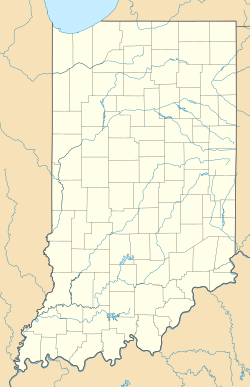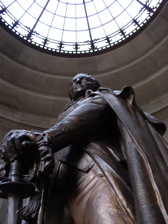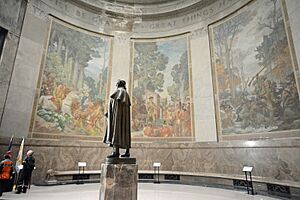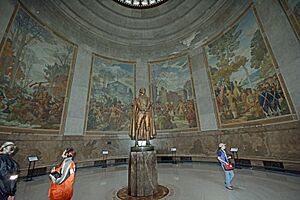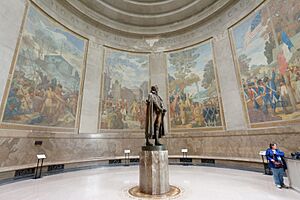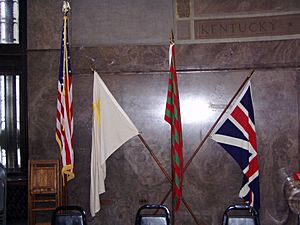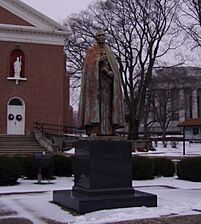George Rogers Clark National Historical Park facts for kids
|
George Rogers Clark National Historical Park
|
|
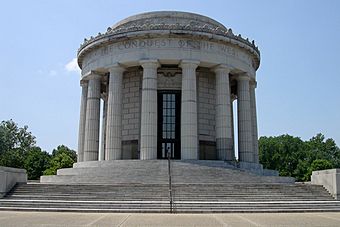
The George Rogers Clark Memorial
|
|
| Location | 2nd St, S of U.S. 50, Vincennes, Indiana, United States |
|---|---|
| Area | 24.3 acres (9.8 ha) |
| Built | 1931 |
| Visitation | 145,596 (2011) |
| Website | George Rogers Clark National Historical Park |
| NRHP reference No. | 66000007 |
Quick facts for kids Significant dates |
|
| Added to NRHP | October 15, 1966 |
| Designated NHP | July 23, 1966 |
The George Rogers Clark National Historical Park is a special place in Vincennes, Indiana. It sits by the Wabash River where people believe Fort Sackville once stood. This park is a United States National Historical Park that remembers an important event in American history.
In 1936, President Franklin D. Roosevelt officially opened a beautiful memorial building here. This memorial was first approved by President Calvin Coolidge.
The park honors George Rogers Clark, a brave soldier from the American Revolutionary War. On February 25, 1779, Clark and his men captured Fort Sackville from the British. This victory was a huge deal for the American cause. Clark's older brother was William Clark, who later explored the American West.
Clark's journey with his soldiers from Kaskaskia in the middle of winter was very difficult. Their success against the British is still seen as one of the most amazing achievements of the American Revolution.
In 1966, the state of Indiana gave this important site to the National Park Service. Next to the memorial, there is a visitor center. Here, you can learn more about the history through programs and displays. The park is part of the Vincennes Historic District.
Contents
The Story of George Rogers Clark
Clark's Bold Campaign
The memorial stands where Fort Sackville is thought to have been. While we don't have exact proof of the fort's spot, it's definitely within the park. This area celebrates General George Rogers Clark's greatest moment.
The state of Virginia sent Clark to protect its lands in the "Old Northwest." This was a large area that would later become states like Ohio and Indiana. In 1778 and 1779, Clark's campaign led to the founding of Louisville, Kentucky. His forces also captured British forts in the Ohio and Mississippi valleys.
Clark's men had captured Fort Sackville earlier. But when the British, led by Henry Hamilton, took it back, Clark knew he had to act fast. He led a daring march to recapture the fort for the Americans. They succeeded on February 25, 1779.
Winning the Northwest Territory
This important victory helped the newly formed United States claim a vast area of land. This land would eventually become the states of Ohio, Illinois, Indiana, Michigan, and Wisconsin. These claims were officially recognized in the 1783 Treaty of Paris, which ended the American Revolution.
Building the Memorial
As Vincennes grew in the 1800s, the exact location of Fort Sackville was lost. In 1905, the Daughters of the American Revolution placed a stone marker where they believed the fort was.
In 1929, people in Vincennes wanted to celebrate the 150th anniversary of Clark's campaign. The state of Indiana, with help from the U.S. government, decided to build a grand memorial. They raised $2.5 million for the project.
New York architect Frederic Charles Hirons designed the memorial. President Franklin Roosevelt dedicated it on June 14, 1936.
Exploring the Memorial Structures
The Main Memorial Building
The main memorial building is a round structure made of granite. It has sixteen tall, fluted Greek Doric columns all around it. On top, there's a saucer dome made of glass panels.
Visitors walk up thirty granite steps to enter the memorial. Inside, you'll find plastered walls, marble on the lower parts of the walls, and terrazzo floors.
Statues and Other Features
The park has other important statues and features:
- A granite statue of Francis Vigo by John Angel. Vigo was an Italian-American merchant who helped General Clark. This monument is 4-by-9-foot (1.2 by 2.7 m) and overlooks the Wabash River.
- A bronze statue by Albin Polasek honoring Father Pierre Gibault. He was another important figure in the Revolutionary War. This statue is located on the grounds of the Basilica of St. Francis Xavier.
- The Lincoln Memorial Bridge crosses the Wabash River. Raoul Josset designed it to match the memorial's style. On the Illinois side of the bridge, there's a monument by Nellie Walker. It celebrates the journey of Abraham Lincoln and his family.
- A concrete floodwall protects the memorial and Vincennes from the Wabash River. It's also designed in a classic style.
- You can also find a memorial for soldiers from Knox County who served in World War I.
- There's a marker showing where Clark's headquarters likely stood during his attack on Fort Sackville.
- The original Daughters of the American Revolution memorial stone is also still here.
Art Inside the Memorial
Inside the memorial, you can see a series of seven large paintings, called murals. These were created by the artist Ezra Winter. They tell the story of George Rogers Clark and his campaign.
Why This Park is Important
Celebrating American Expansion
The George Rogers Clark National Historical Park was created to remember the amazing achievements of George Rogers Clark. It also celebrates how the United States grew into the Northwest Territory. The park helps tell this important story to all Americans. It also works to protect and explain other historical sites in Vincennes connected to this history.
The park also honors the actions of Father Pierre Gibault and Francis Vigo. They both supported Clark against the British during the war.
A Key Revolutionary War Site
The park is built on the site of Fort Sackville. Clark captured this fort from the British during the American Revolution on February 25, 1779. This victory helped America claim more land in the Ohio Valley. It also played a part in the United States getting the Northwest Territory in the 1783 Treaty of Paris.
Even though no buildings from the Revolution still stand in the park today, its history is very real. The park helps us understand the "Revolution, War in the Frontier" theme in American history.
Keeping the Memorial Strong
Recent Renovations
In 2008, the George Rogers Clark National Historical Park closed for 13 months. This was for a big renovation project that cost three million dollars. Park Superintendent Dale Phillips said this was a "once-in-a-lifetime restoration project." It was very important for keeping the Clark Memorial safe for many years.
The main goal was to fix a long-standing problem with water drainage on the terrace. This area had been leaking since the 1930s. They also renovated the access steps. The monument reopened on September 24, 2009, and was rededicated on October 3, 2009.
What the Renovation Included
During the renovation, workers did many things:
- They removed and installed new parts of the walls and decorative elements.
- They repaired cracks in the walls.
- They carefully removed, stored, and numbered about 1,000 large granite paving stones.
- They installed new waterproofing on the plaza's concrete deck and the monument's base.
- They cleaned and repaired the granite stone, steps, and outer layers.
- They put in a new walking surface around the Monument plaza.
- They replaced the sprinkler system and updated the landscaping.
These repairs fixed problems that were first noticed way back in 1939.
A Quarter for Indiana
The George Rogers Clark National Historical Park was featured on an America the Beautiful Quarter in 2017. This special quarter represented the state of Indiana.
Gallery
-
Flag display in the monument
See also
 In Spanish: Parque Histórico Nacional George Rogers Clark para niños
In Spanish: Parque Histórico Nacional George Rogers Clark para niños


